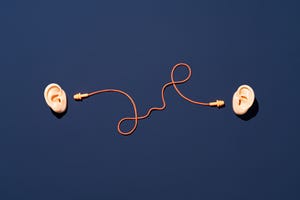
What Is 'Hidden Hearing Loss' and How to Tell if You Have It - CNET
You’re trying to listen to your friend in a crowded restaurant or follow a story someone’s telling at a party. The problem? You can’t make out most of it.
That raises some red flags for your hearing. And since hearing loss and noise pollution are both on the rise, you know you should look into it. So you might schedule a visit to an audiologist to get your hearing tested. The test comes back normal, though. The audiologist happily tells you that your hearing isn’t impaired.
But then you’re back in a noisy setting. This time, you know you’re not hearing well. You’re not losing your mind. You’re probably dealing with hidden hearing loss.
What is hidden hearing loss?
Getting diagnosed with hidden hearing loss — also called hidden hearing disorder — means you hear fine in quiet and normal-volume environments but you struggle once background noise is introduced.
Researchers at Massachusetts Eye and Ear — a research center and teaching hospital of Harvard Medical School — recently published a study summarizing their findings after reviewing more than 100,000 patient records from a 16-year period. They found that roughly one in 10 had hidden hearing loss. In other words, 10% of people who visited their audiology clinic and had normal audiograms still reported trouble hearing.
It’s difficult to estimate how many people have this problem because the hearing testing we historically use — listening for tones in a quiet room — doesn’t pick up background noise-impacted hearing difficulties. In fact, that’s why hearing experts call this condition hidden hearing loss.
The Massachusetts Eye and Ear researchers theorized that hidden hearing loss comes from a different cause than other hearing loss. While traditional hearing loss arises when the sensory cells in your inner ear get damaged by any number of causes, hidden hearing disorder is different. Researchers believe it might develop because of connectivity and communication issues in the nerve cells of the brain.
Whatever the cause, hidden hearing loss can make daily life difficult. Let’s look at a few of the ways this hearing disorder can affect you.

Signs you have hidden hearing loss
As the National Institutes of Health reported, researchers are still finding ways to accurately diagnose hidden hearing loss. It’s important to be able to recognize the signs of this condition in yourself or your loved ones.
Some of the leading symptoms include:
- Passing a hearing test but struggling to hear in loud environments.
- Pretending you can hear or giving up on following conversations when there’s a lot of background noise.
- Avoiding certain situations that you know will be noisy.
- Struggling to focus once background noise reaches a certain volume.
- Hearing people incorrectly when you’re not in a quiet setting.
Ultimately, hidden hearing loss symptoms only present themselves when there’s other noise competing for your attention. For example, you might have trouble hearing a colleague in your busy office or a friend telling you a story at a social event.

Getting treatment
If you think you may have hidden hearing loss, talk to your doctor and an audiologist. If you take and pass a hearing test, explain to them that you think you have hidden hearing disorder. Other tests can help identify it, including tests that involve trying to recognize words in background noise (often called a speech-in-noise test).
The audiologist should be able to help you develop tools and strategies to improve your ability to hear and understand others. Generally, this won’t mean using hearing aids in the traditional way because they amplify all sound, not just the person you want to hear. However, new technology allows certain models to filter out background noise or amplify sounds from certain directions and not others, which can be helpful for this condition.
Some techniques that you can try include:
- Asking people to speak more slowly (this is generally more effective than asking them to speak more loudly).
- Sitting or standing directly facing the person you want to hear.
- Sitting or standing in a location with the background noise behind you.
- Asking to be seated in a booth or other noise-blocking location when dining out.
- Prioritizing quieter times and settings when possible.
- Learning lip reading.
- Using closed captions.
- Using an app on your phone to give you a directional microphone.
That last one can be a boon if you’re really struggling with hidden hearing loss. These apps essentially give you a way to turn your phone into a microphone. When you place it near the person you’re trying to hear, it feeds their voice into your headphones or hearing aids. A couple of apps that give your phone directional microphone functionality include Ear Machine, which was developed with funding from the NIH, and Apple’s built-in Live Listen. There are also hearing aids and assistive devices with this technology.
Researchers are on the hunt for ways to both diagnose and treat hidden hearing loss more effectively. While the strategies and tools we just outlined should help you today, a more effective solution might come to light in the future.

